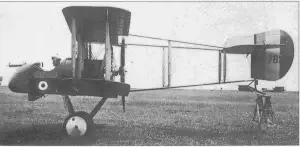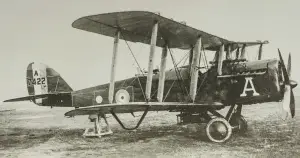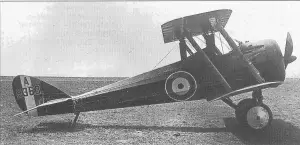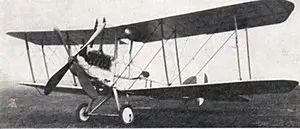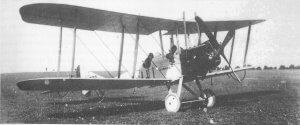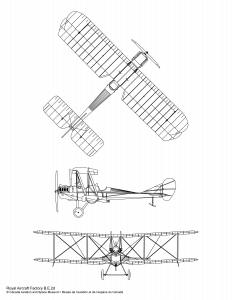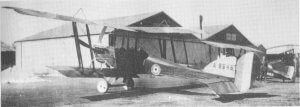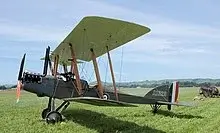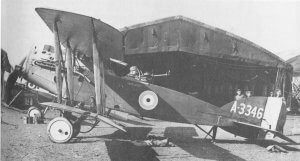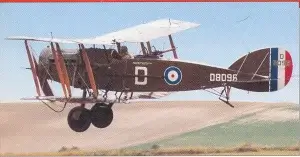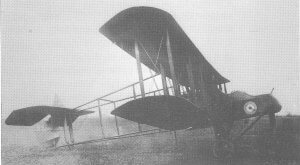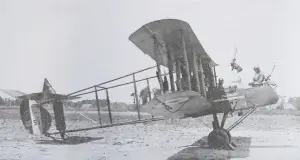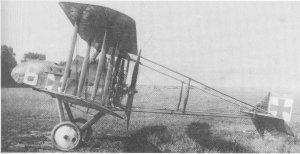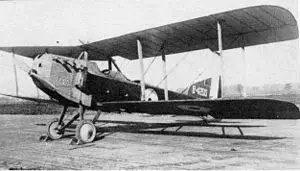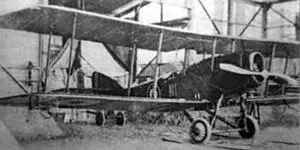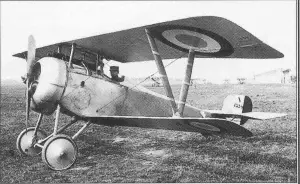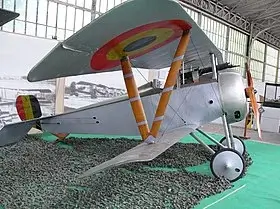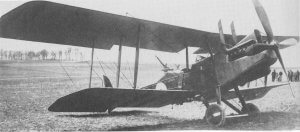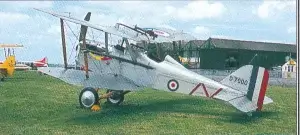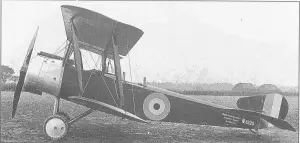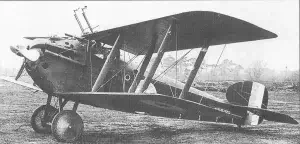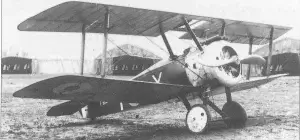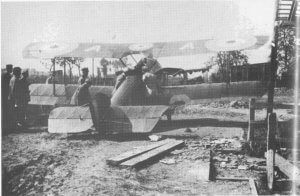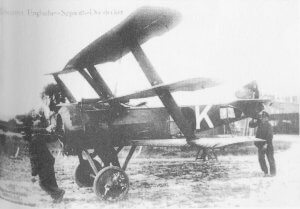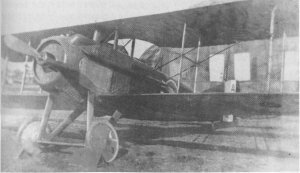Un Chasseur par Aircraft Manufacturing Company.
Moteur: 1 moteur rotatif Gnome Monosoupape de 75 kW (100 ch) (et plus tard un rotatif Rhône de 82 kW)
Armement: 1 mitrailleuse Lewis de 7,62 mm avec disques de 47 coups)
Constituant l’équipement du premier escadron britannique de chasseurs monoplaces, le D.H.2 a été introduit en 1916 comme un biplan robuste destiné à contrer la série Fokker E. Une configuration à hélice propulsive a été choisie, car le Royaume-Uni ne disposait pas de mécanisme d’interruption de tir. Le montage d’origine permettait d’élever le canon, mais il a rapidement été remplacé par un montage fixe, les pilotes ayant appris à viser la cible avec l’ensemble de l’avion, en utilisant les commandes très réactives pour tirer le meilleur parti de cette machine agile. La production s’éleva à environ 400 appareils et, à partir du printemps 1916, le D.H.2 contribua à vaincre le « fléau Fokker » et à donner ainsi la supériorité aérienne aux Britanniques. Faute de remplacement, ce type d’appareil continua à servir jusqu’au milieu de l’année 1917. (Source : The International Encyclopedia of Aircraft, Oriole Publishing, 1991)
Envergure: 8.61 m (28.2 ft)
Longueur: 7.68 m (25 ft)
Hauteur: 2.91 m (9.5 ft)
Surface de l'aile : 23.13 m² (248.97 ft²)
Poids à vide : 428 kg (943 lbs)
Poids Max.: 654 kg (1442 lbs)
Vitesse max.: 150 km/h (93 mph)
Plafond: 4265 m (13.993 ft)
Endurance: 2.75 heures
Taux de montée :
Un Bombardier par Aircraft Manufacturing Company.
Moteur: 1 Rolls-Royce Eagle VIII 12 cylindres refroidi par eau de 280 kW (375 ch)
Armement: 2 mitrailleuses Vickers de 7,7 mm + 2 mitrailleuses Lewis de 7,7 mm + bombes de 209 kg
Le D.H.4, l’un des avions les plus performants de la Première Guerre mondiale, a été spécialement conçu comme bombardier. Après son premier vol en août 1916, il a été équipé d’un moteur Rolls-Royce Eagle, qui a amélioré ses performances de vol. Environ 6 300 exemplaires ont été construits, dont plus des deux tiers aux États-Unis. La production s’est poursuivie après la fin de la guerre, et les D.H.4 ont été utilisés par diverses forces aériennes et certaines des premières compagnies aériennes. (source : Avions du monde, IMP BV)
Envergure: 12.92 m (42.3 feet)
Longueur: 9.35 m (30.6 ft)
Hauteur: 3.35 m (11 ft)
Surface de l'aile : 40.32 m² (434 ft²)
Poids à vide : 1083 kg (2387 lbs)
Poids Max.: 1575 kg (3472 lbs)
Vitesse max.: 230 km/u (143 mph)
Plafond: 6705 m (21.998 ft)
Endurance: 2.75 heures
Taux de montée :
Un Chasseur par Aircraft Manufacturing Company.
Moteur: 1 Le Rhône 9 82 kW (110 ch)
Armement: 1 mitrailleuse de 7,7 mm + 4 bombes de 11,3 kg
Le D.H.2 offrait à son pilote un excellent champ de vision. Lors de la conception du D.H.5, destiné à le remplacer, avec un moteur tracteur et un canon interrompu, de Havilland choisit un décalage vers l’arrière des ailes afin d’offrir au pilote un champ de vision tout aussi bon. À tous autres égards, le D.H.5 était tout à fait conventionnel, avec une structure en bois renforcée par des haubans, un revêtement en tissu et un train d’atterrissage à patin arrière fixe. Le premier exemplaire vola à la fin de 1916 et, malgré des performances nettement inférieures à celles du Pup contemporain, une commande de 400 appareils fut passée, dont les premiers entrèrent en service en mai 1917. Seules cinq escadrilles reçurent ce type d’appareil, dont les capacités de combat aérien médiocres le reléguèrent rapidement au rôle d’attaque au sol. Le D.H. s’est avéré beaucoup plus adapté à cette tâche, et 150 commandes supplémentaires ont été passées, mais tous n’ont pas été construits avant le retrait de ce modèle à la fin de 1917. (Source : The International Encyclopedia of Aircraft, Oriole Publishing, 1991)
Envergure: 7.82 m (25 ft 8in)
Longueur: 6.71 m (22 ft)
Hauteur:
Surface de l'aile :
Poids à vide :
Poids Max.: 667 kg (1492 lbs)
Vitesse max.: 165 km/u (102 mph)
Plafond:
Endurance: 2.75 heures
Taux de montée :
Un Avion polyvalent par Royal Aircraft Factory.
Moteur:
Armement:
Envergure:
Longueur:
Hauteur:
Surface de l'aile :
Poids à vide :
Poids Max.:
Vitesse max.:
Plafond:
Endurance: 2.75 heures
Taux de montée :
Un Avion de reconnaissance et bombardier léger par Royal Aircraft Factory.
Moteur: Moteur 8 cylindres en ligne RAF 1a refroidi par air de 67 kW (90 ch)
Armement: 1 mitrailleuse de 7,7 mm et bombes de 100 kg
Envergure: 11.3 m (37 ft)
Longueur: 8.3 m (27.2 ft)
Hauteur: 3.4 m (11.1 ft)
Surface de l'aile : 34.47 m² (371 ft²)
Poids à vide : 621 kg (1369 lbs)
Poids Max.: 1077 kg (2374.3 lbs)
Vitesse max.: 138 km/h (85.7 mph)
Plafond: 3050 m (10.000 ft)
Endurance: 2.75 heures
Taux de montée : 1066 m (3497 ft) in 10 minutes
Un Avion de reconnaissance et bombardier léger par Royal Aircraft Factory.
Moteur:
Armement:
Envergure:
Longueur:
Hauteur:
Surface de l'aile :
Poids à vide :
Poids Max.:
Vitesse max.:
Plafond:
Endurance: 2.75 heures
Taux de montée :
Un Avion de reconnaissance et bombardier léger par Royal Aircraft Factory.
Moteur:
Armement:
Envergure:
Longueur:
Hauteur:
Surface de l'aile :
Poids à vide :
Poids Max.:
Vitesse max.:
Plafond:
Endurance: 2.75 heures
Taux de montée :
Un Avion de reconnaissance et bombardier léger par Royal Aircraft Factory.
Moteur:
Armement:
Envergure:
Longueur:
Hauteur:
Surface de l'aile :
Poids à vide :
Poids Max.:
Vitesse max.:
Plafond:
Endurance: 2.75 heures
Taux de montée :
B.E.2g
Un Avion de reconnaissance et bombardier léger par Royal Aircraft Factory.
Moteur:
Armement:
Envergure:
Longueur:
Hauteur:
Surface de l'aile :
Poids à vide :
Poids Max.:
Vitesse max.:
Plafond:
Endurance: 2.75 heures
Taux de montée :
Un Chasseur biplace par Bristol Airplane Company.
Moteur:
Armement:
Envergure:
Longueur:
Hauteur:
Surface de l'aile :
Poids à vide :
Poids Max.:
Vitesse max.:
Plafond:
Endurance: 2.75 heures
Taux de montée :
Un Chasseur par Bristol Airplane Company.
Moteur: 1 moteur en ligne Rolls-Royce Falcon III 12 cylindres de 205 kW (275 p)
Armement: 3 mitrailleuses de 7,7 mm + bombes de 108 kg
Au cours de la période qui a suivi la Première Guerre mondiale, alors que la Royal Air Force réduisait ses effectifs, le Bristol F.2B Fighter a été pendant des années l’un des principaux avions de combat britanniques. En effet, après que les pilotes de la RAF eurent subi de lourdes pertes pendant la guerre avec l’ancien F.2A, de nouvelles procédures de mission plus efficaces furent mises au point pour le F.2B. Utilisé comme avion de liaison et d’attaque légère, il resta en service dans les forces armées jusqu’aux années 1930. (Source : Vliegtuigen van de wereld, IMP BV)
Envergure: 11.96 m (39 ft)
Longueur: 7.87 m (25.8 ft)
Hauteur: 2.97 m (9.7 ft)
Surface de l'aile : 37.62 m² (405 ft²)
Poids à vide : 975 kg (2149 lbs)
Poids Max.: 1474 kg (3249 lbs)
Vitesse max.: 198 km/h (125 mph)
Plafond: 5485 m (17.995 ft)
Endurance: 2.75 heures
Taux de montée : to 3048 m (10.000 ft) in 11'15"
Un Chasseur par Royal Aircraft Factory.
Moteur: Moteur Beardmore en ligne refroidi par liquide de 119,3 kW (160 ch)
Armement: 1 ou 2 mitrailleuses Lewis de 7,7 mm et une charge de bombe externe de 235 kg)
Envergure: 14.55 m (47.47 ft)
Longueur: 9.83 m (32.2 ft)
Hauteur: 3.85 m (12.6 ft)
Surface de l'aile : 45.89 m² (494 ft²)
Poids à vide : 935 kg (2061 lbs)
Poids Max.: 1378 kg (3038 lbs)
Vitesse max.: 147 km/h (91 mph)
Plafond: 3353 m (11.000 ft)
Endurance: 2.75 heures
Taux de montée :
Un par Royal Aircraft Factory.
Moteur:
Armement:
Envergure:
Longueur:
Hauteur:
Surface de l'aile :
Poids à vide :
Poids Max.:
Vitesse max.:
Plafond:
Endurance: 2.75 heures
Taux de montée :
Un Chasseur par Royal Aircraft Factory.
Moteur: 1 moteur rotatif Gnome Monosoupape de 75 kW (100 ch) (et plus tard un rotatif Rhône de 82 kW)
Armement: 1 mitrailleuse de 7,7 mm
Envergure: 9.6 m (31.4 ft)
Longueur: 7.21 m (23.6 ft)
Hauteur:
Surface de l'aile :
Poids à vide :
Poids Max.: 610kg (1345 lbs)
Vitesse max.: 152 km/h (94 mph)
Plafond:
Endurance: 2.75 heures
Taux de montée :
Un Avion de reconnaissance par Armstrong Whitworth.
Moteur: 120/160 ch Beardmore
Armement: 1 Vickers/1 Lewis
Envergure:
Longueur:
Hauteur:
Surface de l'aile :
Poids à vide :
Poids Max.:
Vitesse max.: 134/153 kph @ 1981 m
Plafond: 3657 m
Endurance: 2.75 heures
Taux de montée :
Un Bombardier par Martinsyde.
Moteur:
Armement:
Envergure:
Longueur:
Hauteur:
Surface de l'aile :
Poids à vide :
Poids Max.:
Vitesse max.:
Plafond:
Endurance: 2.75 heures
Taux de montée :
Un Chasseur par Nieuport.
Moteur: 1 moteur rotatif Le Rhône (Type 17) de 89 kW (119 CV) ou 1 Clerget (Type 17bis) de 97 kW (130 CV)
Armement: 1 mitrailleuse Vickers ou Lewis de 7,7 mm
Le Nieuport Type 17 était le modèle phare de son constructeur et l’un des avions de combat les plus importants des Alliés pendant la Première Guerre mondiale. Aboutissement du développement des chasseurs-éclaireurs par Nieuport, il connut un tel succès qu’il fut adopté par la plupart des Alliés, y compris la Russie et les États-Unis. De nombreux pilotes de haut niveau de la Première Guerre mondiale ont volé avec cet appareil, dont ils appréciaient la maniabilité et la grande capacité d’ascension. (Source : Avions du monde, IMP BV)
Envergure: 8.2 m (27 ft)
Longueur: 5.96 m (19.5 ft)
Hauteur: 2.44 m (8 ft)
Surface de l'aile : 14.75 m² (158.76 ft²)
Poids à vide : 374 kg (824.5 lbs)
Poids Max.: 560 kg (1234.5 lbs)
Vitesse max.: 170 km/u (
Plafond: 5350 m (17.552 ft)
Endurance: 2.75 heures
Taux de montée :
Un par Nieuport.
Moteur:
Armement:
Envergure:
Longueur:
Hauteur:
Surface de l'aile :
Poids à vide :
Poids Max.:
Vitesse max.:
Plafond:
Endurance: 2.75 heures
Taux de montée :
Un Avion d'observation par Royal Aircraft Factory.
Moteur: Moteur en V 12 cylindres refroidi par air RAF 4a 112 kW (150 ch)
Armement: 2 ou 3 mitrailleuses de 7,7 mm et bombes de 116 kg maximum (2x51 kg ou 4x29 kg ou 8x9 kg)
Envergure: 12.98 m (42.5 ft)
Longueur: 8.5 m (27.8 ft)
Hauteur: 3.47 m (11.3 ft)
Surface de l'aile : 35.07 m² (377.5 ft²)
Poids à vide : 717 kg (1580 lbs)
Poids Max.: 1301 kg (2868 lbs)
Vitesse max.: 164 km/h (102 mph)
Plafond: 4115 m (13.500 ft)
Endurance: 2.75 heures
Taux de montée :
Un Avion d'observation par Royal Aircraft Factory.
Moteur: 1 moteur Hispano-Suiza V-8 149 kW
Armement: 1 mitrailleuse Vickers de 7,7 mm + 1 mitrailleuse Lewis de 7,7 mm + 4 bombes de 18,6 kg
Le S.E.5a était l’un des meilleurs avions d’observation de la Première Guerre mondiale. Il a été conçu par H.P. Folland à la Royal Aircraft Factory de Farnborough. Après avoir surmonté quelques problèmes de jeunesse, les meilleurs pilotes britanniques ont remporté de grands succès avec cet appareil. Malgré ses formes anguleuses, le S.E.5a était bien proportionné, extrêmement rapide et constituait une plate-forme d’armement très stable. Toutes ces caractéristiques compensaient son manque de maniabilité. (Source : Avions du monde, IMP BV)
Envergure: 8.12 m
Longueur: 6.38 m
Hauteur: 2.9 m
Surface de l'aile : 22.67 m²
Poids à vide : 635 kg
Poids Max.: 887 kg
Vitesse max.: 218 km/u
Plafond: 6705 m
Endurance: 2.75 heures
Taux de montée :
Un Chasseur/Bombardier par Sopwith Aviation Company.
Moteur: 1 Clerget 99,7 kW (130 ch)
Armement: 2 mitrailleuses de 7,7 mm
On pense que cet avion a été ainsi surnommé parce que ses entretoises de cabane ressemblaient à des entretoises interplanaires coupées en deux. Le 1 1/2 Strutter fut le premier avion britannique équipé d’un canon interrompu, complété par un canon orientable dans le cockpit arrière. Ayant effectué son premier vol en décembre 1915 avec un moteur rotatif Clerget de 82 kW (110 ch), ce modèle répondait à une exigence de la marine et s’est révélé si performant qu’il a été produit à grande échelle sous les désignations Admiralty Type 9700 et Two-seater respectivement pour la marine et l’armée. Il a été produit en version biplace et monoplace, cette dernière étant un bombardier utilisé presque exclusivement par la marine. Les livraisons ont commencé au printemps 1916, et la production britannique totale de 1 513 1 1/2 Strutter a été complétée par environ 4 500 appareils construits en France. Le remplacement par des chasseurs plus agiles et plus performants a commencé en juillet 1917. (source : The International Encyclopedia of Aircraft, Oriole Publishing, 1991)
Envergure: 10.21 m (33.5 ft)
Longueur: 7.97 m (26.1 ft)
Hauteur:
Surface de l'aile :
Poids à vide :
Poids Max.: 974 kg (2150 lbs)
Vitesse max.: 161 km/h (100 mph)
Plafond:
Endurance: 2.75 heures
Taux de montée :
Un Chasseur par Sopwith Aviation Company.
Moteur: 1 x Hispano-Suiza V-8 149 kW (200 ch)
Armement: 3 ou 4 mitrailleuses de 7,7 mm + 4 bombes de 11,3 kg
Contrairement aux précédents chasseurs Sopwith, le Dolphin était propulsé par un moteur statique, et son fuselage profond comblait pratiquement l’espace entre les ailes décalées vers l’arrière, de sorte que le pilote était assis la tête dépassant par une ouverture dans la partie centrale de l’aile supérieure, ce qui lui offrait un excellent champ de vision dans l’hémisphère supérieur. Le prototype vola en mai 1917 avec un moteur à engrenages Hispano-Suiza de 149 kW (200 ch), et le même groupe motopropulseur fut utilisé dans le Dolphin Mk I qui entra en service à la fin de 1917. Des problèmes avec le moteur à engrenages ont ensuite conduit au Dolphin Mk III, équipé d’une version à entraînement direct du même moteur, et la désignation Dolphin Mk II a été utilisée pour quelques avions équipés d’un moteur Hispano-Suiza à entraînement direct de 224 kW (300 ch). Au total, 1 532 exemplaires furent produits, mais seuls 621 furent livrés aux escadrons opérationnels, qui n’appréciaient guère les caractéristiques inhabituelles du Dolphin en matière de décrochage et la vulnérabilité du pilote en cas d’accident lors d’un atterrissage sur le nez. (Source : The International Encyclopedia of Aircraft, Oriole Publishing, 1991)
Envergure: 9.91 m (32 ft 6 in)
Longueur: 6.78 m (22 ft 3 in)
Hauteur:
Surface de l'aile :
Poids à vide :
Poids Max.:
Vitesse max.: 180 km/h (112 mph)
Plafond:
Endurance: 2.75 heures
Taux de montée :
Un Chasseur par Sopwith Aviation Company.
Moteur: 1 moteur à pistons Clerget 9 cylindres refroidi par air 97 kW (131 ch)
Armement: 2 mitrailleuses Vickers de 7,7 mm + 4 bombes de 11,35 kg
En termes d’avions détruits (1 294), le Camel était le meilleur chasseur britannique de la Première Guerre mondiale, et 5 490 exemplaires ont été construits. Ce modèle était dérivé du Pup et a commencé à entrer en service au milieu de l’année 1917. Son surnom de « Camel » (chameau) lui vient de la bosse située à l’avant du fuselage, au-dessus des deux mitrailleuses. Il était propulsé par l’un des quatre moteurs rotatifs d’une puissance comprise entre 75 et 112 kW (100 à 150 ch), et la concentration des masses principales (moteur, carburant, armement et pilote) autour du centre de gravité dans le fuselage avant conférait à cet avion de chasse une agilité exceptionnelle, même si ses caractéristiques de virage étaient suffisamment délicates pour poser de sérieux problèmes de maniabilité à tous les pilotes, sauf les plus expérimentés. Il existait également une version navale 2F.1 avec un seul canon, une envergure réduite et une queue amovible. (Source : The International Encyclopedia of Aircraft, Oriole Publishing, 1991)
Envergure: 8.53 m (28 ft)
Longueur: 5.72 m (18.7 ft)
Hauteur: 2.6 m (8.5 ft)
Surface de l'aile : 21.46 m² (231 ft²)
Poids à vide : 421 kg (928 lbs)
Poids Max.: 659 kg (1453 lbs)
Vitesse max.: 188 km/h (117 mph)
Plafond: 5790 m (18.996 ft)
Endurance: 2.75 heures
Taux de montée : 3000 m (9842 ft) in 10'
Un Chasseur par Sopwith Aviation Company.
Moteur: 1 moteur rotatif Le Rhône 60 kW (80 ch)
Armement: 1 mitrailleuse Vickers de 7,7 mm et bombes Cooper de 11,3 kg maximum
Envergure: 8.08 m (26.5 ft)
Longueur: 6.04 m (19.8 ft)
Hauteur: 2.87 m (9.4 ft)
Surface de l'aile : 23.6 m² (254 ft²)
Poids à vide : 357 kg (787 lbs)
Poids Max.: 556 kg (1226 lbs)
Vitesse max.: 180 km/h (112 mph)
Plafond: 5335 m (17.503 ft)
Endurance: 2.75 heures
Taux de montée : to 4907 m (16.099 ft) in 35 minutes
Un Chasseur par Sopwith Aviation Company.
Moteur: 1 moteur rotatif Clerget 9B 9 cylindres refroidi par air de 96,9 kW (130 ch)
Armement: 1 mitrailleuse Vickers de 7,7 mm
Envergure: 8.08 m (26.5 ft)
Longueur: 5.94 m (19.4 ft)
Hauteur: 3.2 m (10.4 ft)
Surface de l'aile : 21.46 m² (231 ft²)
Poids à vide : 450 kg (992 lbs)
Poids Max.: 642 kg (1415 lbs)
Vitesse max.: 187 km/u (116 mph)
Plafond: 6250 m (20.505 ft)
Endurance: 2.75 heures
Taux de montée : to 3050 m (10.000 ft) in 10.5 minutes
Un Chasseur par Société Pour L'Aviation et ses Dérivés.
Moteur: 1 moteur V8 Hispano-Suiza 8Ab en ligne - 134 kW (180 ch)
Armement: 1 mitrailleuse de 7,7 mm (500 coups)
Envergure: 7.82 m (25.6 ft)
Longueur: 6.08 m (19.9 ft)
Hauteur: 2.2 m (7.2 ft)
Surface de l'aile : 17.85 m² (192 ft²)
Poids à vide : 500 kg (1102 lbs)
Poids Max.: 705 kg (1554 lbs)
Vitesse max.: 212 km/u (131 mph)
Plafond: 6550 m (
Endurance: 2.75 heures
Taux de montée : 421 m/min (1381 ft/min)
